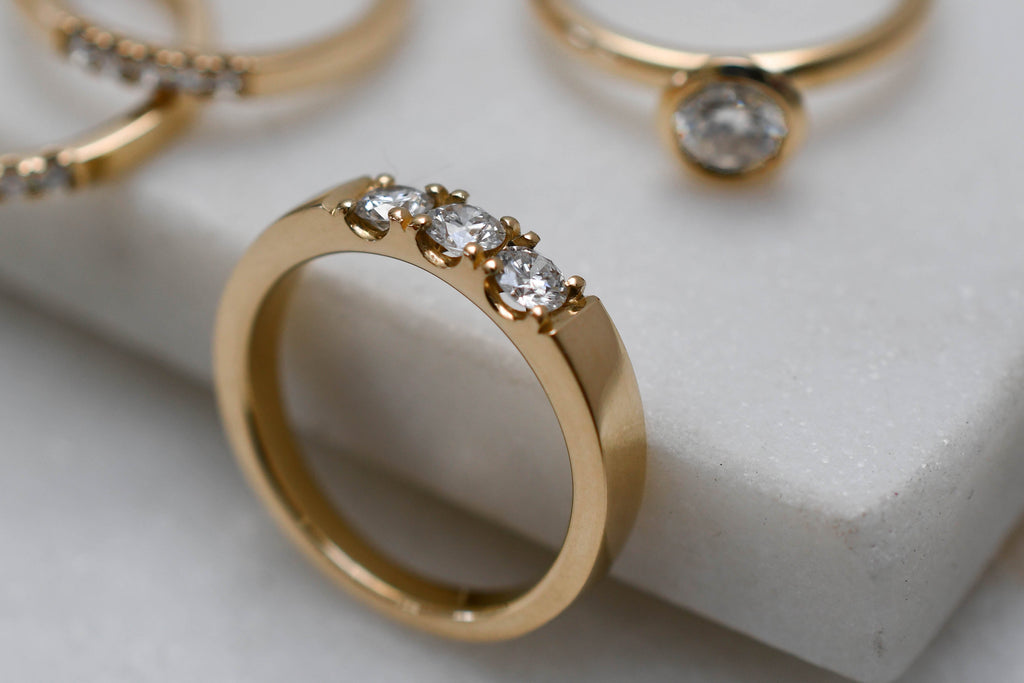The 4 C’s, established by the Gemological Institute of America (GIA), has become the globally recognized grading system for rating a diamond’s quality.
Each diamond, just like each person, has a unique combination of characteristics that make it what it is (and unlike people, play a significant role in determining the diamond's value).
The 4 C’s are:
- Colour
- Clarity
- Cut
- Carat
These are important factors to understand when investing in a special diamond piece but we believe they are only part of a diamond’s story, we believe there is space for a fifth:
- Consideration
CUT
The term “diamond cut” often refers to two separate characteristics which can be confusing.
First, is the overall shape of the diamond; round, princess, emerald cut, etc.

Second, and key to a diamond’s beauty, is the cut grade. This refers to the craftmanship in the cutting of the diamond's facets and affects the light performance of a diamond. It takes patience, skill and experience for an expert diamond cutter to sculpt a rough diamond into a perfectly proportioned sparkling beauty, inaccuracy will affect the diamond’s ability to refract light and therefore it's sparkle (or fire).

Diamond cut grading:
- Excellent: Well proportioned, distributing light evenly through the diamond. This is the highest cut grade.
- Very Good: A majority of the light is still reflected through the crown, or top, of the diamond.
- Good: A diamond with a Good cut will still reflect a good deal of light, but will not appear as brilliant as a higher cut grade.
- Fair: Fair cut diamonds will not display the correct proportions, which will cause a loss of light at the bottom of the diamond, appearing darker than higher cut grades.
CLARITY
Diamonds are composed primarily of carbon. During their formation (both in the earth and in a lab) other elements become trapped inside, giving each diamond its own unique fingerprint. These inclusions help identify the clarity of the diamond.
Diamond Graders study the diamond under 10x magnification to assess a diamond’s clarity and rate them on a scale from Flawless to Imperfect.
- Flawless (FL)
- Internally Flawless (IF)
- Very, Very Slightly Included (VVS) - VVS is divided into two grades VVS1 and VVS2
- Very Slightly Included - VS is also divided into two grades VS1 and VS2
- Slightly Included (SI) - SI is divided into SI1 and SI2
- Imperfect (I) - Imperfect divides into I1, I2 and I3

It is important to remember that this is under 10x magnification and less than 1% of diamonds are graded as Flawless so a good way to maximise your diamond budget is to focus on Very, Very Slightly Included or Very Slighted Included diamonds as most of these will be what is referred to as “eye clean” meaning the imperfections will only be visible under magnification.
COLOUR
A diamond’s colour is valued by its absence – like a drop of pure water, a perfectly structured diamond is completely clear. But because colourless diamonds naturally develop in slightly different shades, a grading scale from D to Z is used to show whether a diamond is truly colourless (D) or off-white (Z). The difference between one colour grade and the next is very subtle, so grading is done under controlled lighting and in precise conditions, using a master diamond sample set for comparison and accuracy.
Diamond colour is categorised in the following colour grades:
- D, E and F: Colourless
- G, H and I: Near Colourless
- J, K and L: Slightly Tinted
- M – R: Very Light Yellow
- S – Z: Light Yellow

“Fancy colour diamonds” i.e. blue, green, yellow-orange, pink, red and black, are celebrated for their saturated hues and are therefore evaluated on a completely different scale.
CARAT
Carat, not to be confused with karat (a measure of the purity of gold), refers to the weight of a diamond. Whilst this does have some correlation with size (diameter), different cuts and shapes will have different size-to-weight ratios. The guide indicates the average size of a round diamond's carat weight but this will be affected by the depth of the cut of each particular stone.

One carat converts to 0.2 grams, which is essentially the same weight as a paper clip. To make matters even more confusing a carat is then also divided into 100 points, so you may hear your jeweller using the phrase ‘pointer’ when referring to carats, a 25 pointer for example is a 0.25 carat diamond. As the diamond carat weight increases, so does its rarity and, of course, the price tag.
CONSIDERATION
We at AuTerra believe that no diamond’s quality assessment can be complete without also considering the quality of the lives of the people who mined it and the sanctity of the place in which it was created.
There are many options when choosing your diamond’s source. Our considerations of planet, people and place have led us to work primarily with lab-grown diamonds. You can read more about these in our blog posts, What exactly are lab-grown diamonds? and Social and ecological impacts of lab-grown vs. mined diamonds. Whatever diamond you decide is right for you we urge you to consider traceability and transparency; our purchasing power is key in creating a more just equitable diamond industry.
*A note on smaller stones: Grading and certification is a process done by skilled eyes and as such is an expensive undertaking. Our smaller stones (2.5mm and below) are not graded as is standard across the industry although we do ensure consistent quality throughout. We also talk about these stones in terms of their mm rather than their carat size for ease of reference.

